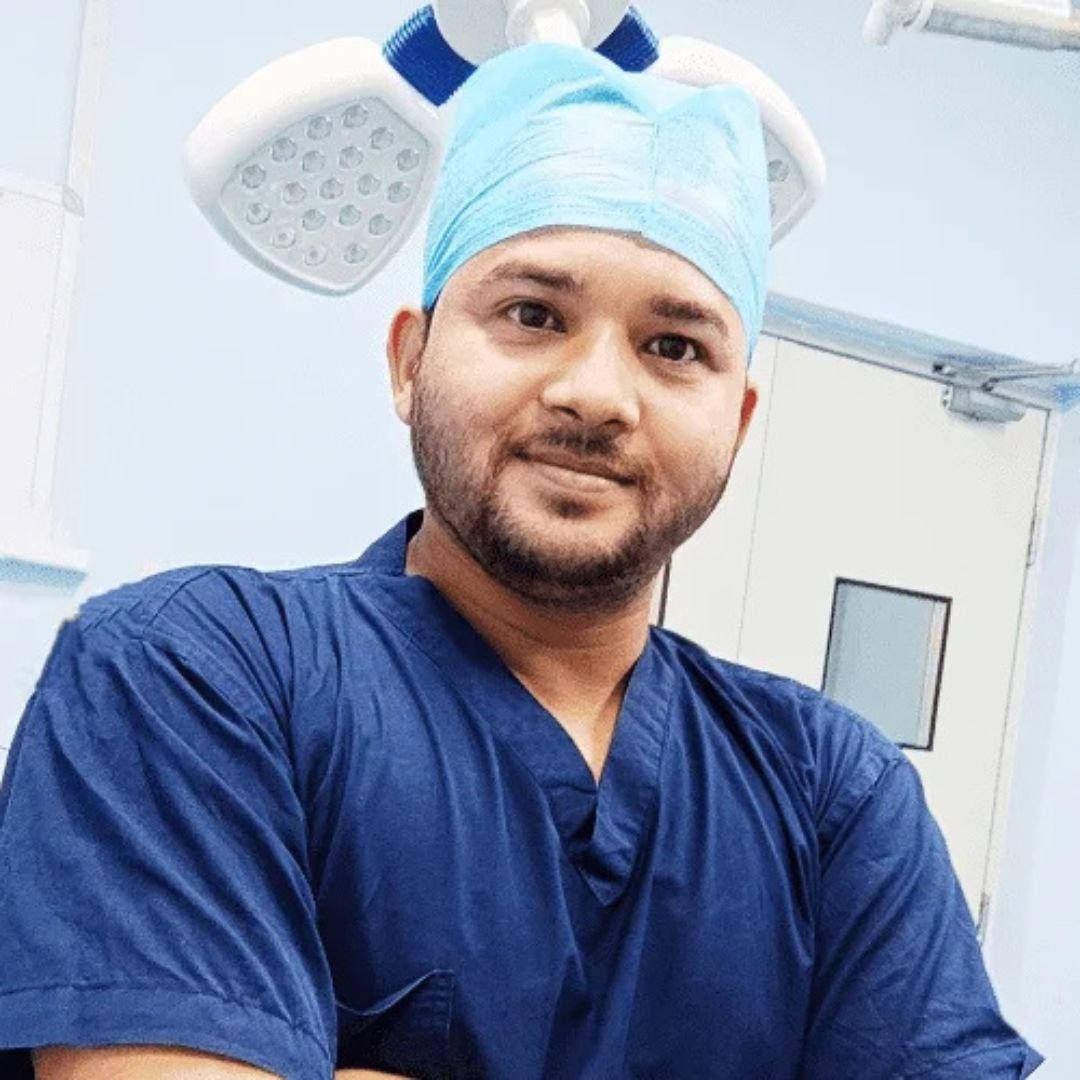Gallstone Treatment - Laparoscopic Surgery Procedure & Operation Benefits
Gallstones are hardened deposits of digestive fluid that form in the gallbladder, a small organ beneath the liver. These deposits can range in size from a grain of sand to a golf ball and can cause severe pain, inflammation, and complications if left untreated. At Bharatkare, we specialize in advanced gallstone removal without surgery and laparoscopic for gallstones, offering patients a safe, effective, and minimally invasive solution. Whether you’re exploring non-surgical options or considering laser surgery for gallstones, our team of experts is here to guide you every step of the way. Book a consultation today to learn more about your treatment options.
Book Appointments With Our Expert Doctors Near You
- Get consultation for 50+ diseases across India
- In-person and online consultation with experienced doctors
- Extensive medical assistance throughout your treatment


Dr Ashish Sachdeva
MBBS, MS - General Surgery, General Surgeon, Bariatric Surgeon, Laparoscopic Surgeon
4.9/5
20 Years Experience
Vadodara, India

Dr. Tanmay Jain
General Surgeon, Laparoscopic Surgeon and Proctologist
4.9/5
12 Years Experience
Jaipur, India

Dr. Vikram Vasuniya
MBBS, MS (General Surgery) General Laparoscopic & Laser Surgeon, Laser Proctologist
4.9/5
14 Years Experience
Bhopal, India

Dr. Sujeet Kumar Bharti
MBBS, MS (General Surgery) General Laparoscopic & Laser Surgeon, Laser Proctologist
4.9/5
22 Years Experience
Patna, India
What Are Gallstones?
Gallstones, also known as cholelithiasis, are solid particles that form from bile cholesterol and bilirubin in the gallbladder. They can vary in size and number, and their presence often leads to symptoms like abdominal pain, nausea, vomiting, and jaundice. Gallstones are classified into two main types:
- Cholesterol Gallstones: These are the most common type, primarily made up of undissolved cholesterol. They often develop due to an imbalance in bile composition.
- Pigment Gallstones: These are smaller and darker, formed from excess bilirubin, a byproduct of red blood cell breakdown.
Gallstones can affect anyone, but certain factors increase the risk, such as obesity, pregnancy, a high-fat diet, and rapid weight loss. While some gallstones remain asymptomatic, others can cause blockages in the bile ducts, leading to complications like cholecystitis (inflammation of the gallbladder) or pancreatitis (inflammation of the pancreas).
If you’ve been diagnosed with gallstones through a gallstone report, it’s essential to explore treatment options tailored to your condition. At Bharatkare, we provide comprehensive care, from gallstone removal without surgery to advanced laparoscopic for gallstones, ensuring optimal outcomes for our patients.
Disease name
Gallstone (Gallbladder Stone)
Surgery name
Cholecystectomy
Duration
45 - 90 minutes
Treated by
General Surgeon
What Are the Symptoms of Gallstones?
Gallstones often go unnoticed until they block the bile ducts or cause inflammation. Common symptoms include:
- Severe Abdominal Pain: Often referred to as a gallbladder attack, this pain typically occurs in the upper right abdomen and can last for several hours.
- Nausea and Vomiting: These symptoms often accompany gallbladder attacks.
- Jaundice: Yellowing of the skin and eyes due to bile duct blockage.
- Fever and Chills: Indicative of an infection or inflammation in the gallbladder.
- Digestive Issues: Bloating, indigestion, and intolerance to fatty foods.
If you experience any of these symptoms, it’s crucial to seek medical attention. A gallstone report from diagnostic tests like ultrasound, CT scan, or MRI can confirm the presence of gallstones and help determine the appropriate treatment plan.
How Can Piles Be Diagnosed?
A piles specialist or anorectal surgeon can diagnose piles through a combination of medical history, physical examination, and diagnostic tests. Here’s an overview of the diagnostic process:
- Medical History: Your healthcare provider will ask about your symptoms, including pain, itching, bleeding, or changes in bowel movements. They will also inquire about your medical history and any previous occurrences of piles.
- Physical Examination: A visual and manual examination of the anal region will be conducted to evaluate for external and internal piles.
- Digital Rectal Examination (DRE): This involves the insertion of a lubricated, gloved finger into the rectum to assess internal piles and check for abnormalities.
- Anoscopy or Proctoscopy: These procedures use a small, lighted tube to examine the anal canal and rectum more closely. They help determine the location, size, and severity of the piles.
- Sigmoidoscopy: A sigmoidoscope is used to view the lower part of the colon and rectum. This procedure helps identify various conditions, including piles.
- Colonoscopy: This procedure examines the entire colon to rule out other serious conditions and confirm the diagnosis of piles.
What Are the Types and Sizes of Gallstones?
Gallstones vary in size, composition, and location, which influences the treatment approach. Understanding the gallstone size for surgery or gallstone size for operation is critical in deciding whether non-surgical or surgical intervention is necessary.
- Small Gallstones: These are typically less than 5mm in diameter and may pass through the bile ducts without causing symptoms. However, they can still lead to blockages or complications.
- Medium Gallstones: Ranging from 5mm to 10mm, these stones are more likely to cause symptoms and may require intervention.
- Large Gallstones: Stones larger than 10mm are less likely to move but can cause significant blockages and inflammation.
The gallstone size for surgery is often determined by the severity of symptoms and the risk of complications. For instance, larger stones or those causing recurrent pain may necessitate laser surgery for gallstones or traditional gallbladder removal.
Why is Laser Piles Treatment Considered the Most Effective Option?
Laser surgery for piles is widely regarded as the safest, quickest, and most effective treatment option. Here’s why:
- Minimally Invasive: Laser surgery requires smaller incisions, resulting in less post-operative pain and faster recovery.
- Reduced Bleeding: The laser cauterizes blood vessels as it cuts, minimizing bleeding during and after the procedure.
- Precise Targeting: The laser targets only the piles tissue, leaving surrounding healthy tissue unaffected.
- Quick Recovery: Most patients can resume normal activities within a few days.
- Lower Risk of Recurrence: Laser surgery effectively treats the underlying piles tissue, reducing the likelihood of recurrence.
How Are Gallstones Diagnosed?
Diagnosing gallstones involves a combination of medical history, physical examination, and diagnostic tests. Here’s an overview of the diagnostic process:
- Medical History: Your doctor will ask about your symptoms, diet, and any family history of gallstones.
- Physical Examination: The doctor may check for tenderness in the upper right abdomen, a common sign of gallbladder inflammation.
- Ultrasound: This is the most common imaging test used to detect gallstones. It provides a detailed view of the gallbladder and bile ducts.
- CT Scan or MRI: These imaging tests offer a more detailed view of the gallbladder and surrounding organs, helping to identify complications like blockages or infections.
- Blood Tests: These can detect signs of infection, inflammation, or jaundice caused by gallstones.
- Endoscopic Retrograde Cholangiopancreatography (ERCP): This procedure is used to locate and remove gallstones in the bile ducts.
A gallstone report from these tests will guide your doctor in recommending the most suitable treatment, whether it’s gallstone removal without surgery or laparoscopic for gallstones.
What Are the Different Treatment Options for Gallstones?
Gallstones can be treated using both non-surgical and surgical methods, depending on the size, location, and severity of symptoms. Here’s a detailed look at the available options:
Non-Surgical Treatments
- Medications: Certain medications can dissolve small cholesterol gallstones over time. However, this approach is slow and may not be effective for larger stones.
- Lifestyle Changes: A healthy diet low in fat and high in fiber can help manage symptoms and prevent the formation of new gallstones.
- Gallstone Removal Without Surgery: Techniques like extracorporeal shock wave lithotripsy (ESWL) use sound waves to break gallstones into smaller pieces, making them easier to pass.
Surgical Treatments
- Laparoscopic for Gallstones: This minimally invasive procedure uses laser energy to break down gallstones, offering a quicker recovery time and fewer complications compared to traditional surgery.
- Laparoscopic Cholecystectomy: This is the most common surgical procedure for gallstone removal, involving the removal of the gallbladder through small incisions.
- Open Surgery: In rare cases, open surgery may be required for complicated or large gallstones.
At Bharatkare, we prioritize laser surgery for gallstones and other minimally invasive techniques to ensure faster recovery and minimal discomfort for our patients.
Diet After Gallstone Operation
After undergoing gallstone removal surgery, it’s crucial to follow a specific diet to aid recovery and prevent complications. The gallbladder plays a role in digesting fats, so its removal requires dietary adjustments to ensure proper digestion and avoid discomfort. Here’s a detailed guide on what to eat and avoid after a gallstone operation:
Recommended Foods
- High-Fiber Foods: Incorporate whole grains, fruits, and vegetables to promote healthy digestion and prevent constipation. Examples include oats, brown rice, apples, and leafy greens.
- Lean Proteins: Opt for lean meats like chicken, turkey, and fish, as well as plant-based proteins like lentils and beans.
- Healthy Fats: Include small amounts of healthy fats from sources like avocados, nuts, seeds, and olive oil. These are easier to digest compared to saturated fats.
- Low-Fat Dairy: Choose low-fat or fat-free dairy products like yogurt, milk, and cheese to avoid overloading your digestive system.
- Hydration: Drink plenty of water throughout the day to support digestion and overall health.
Foods to Avoid
- High-Fat Foods: Avoid fried foods, fatty cuts of meat, and full-fat dairy products, as they can cause digestive discomfort.
- Spicy Foods: These can irritate the digestive system and worsen post-surgery symptoms.
- Processed Foods: Limit intake of processed snacks, sugary foods, and refined carbohydrates, which can disrupt digestion.
- Caffeinated and Carbonated Beverages: These can cause bloating and discomfort.
Following a balanced diet after gallstone operation not only aids recovery but also reduces the risk of developing new gallstones in the bile ducts. For personalized dietary advice, consult your healthcare provider at Bharatkare.
Gallstones After Pregnancy
Pregnancy is a common risk factor for gallstones due to hormonal changes that affect bile composition and gallbladder function. The increased levels of estrogen during pregnancy can lead to higher cholesterol levels in bile, while progesterone slows gallbladder emptying, increasing the likelihood of gallstone formation.
Symptoms of Gallstones After Pregnancy
- Abdominal Pain: Often felt in the upper right side, especially after eating fatty foods.
- Nausea and Vomiting: Common during gallbladder attacks.
- Jaundice: Yellowing of the skin and eyes due to bile duct blockage.
- Fever and Chills: Indicative of an infection or inflammation.
Treatment Options
- Non-Surgical Treatments: For mild cases, medications and lifestyle changes may be recommended.
- Laparoscopic for Gallstones: A minimally invasive option that’s safe for new mothers.
- Surgery: In severe cases, gallbladder removal may be necessary.
If you’re experiencing symptoms of gallstones after pregnancy, it’s essential to seek medical attention. At Bharatkare, we provide tailored treatment plans to ensure the health and well-being of both mother and baby.
Remove Gallstones Without Removing Gallbladder
For patients who wish to preserve their gallbladder, gallstone removal without surgery is a viable option. This approach is particularly suitable for those with small, uncomplicated gallstones. Here are some non-surgical methods:
- Oral Dissolution Therapy: Medications like ursodeoxycholic acid can dissolve cholesterol gallstones over time. However, this method is slow and may take months or years to be effective.
- Extracorporeal Shock Wave Lithotripsy (ESWL): This non-invasive procedure uses sound waves to break gallstones into smaller pieces, allowing them to pass naturally.
- Endoscopic Procedures: Techniques like ERCP (Endoscopic Retrograde Cholangiopancreatography) can remove gallstones from the bile ducts without removing the gallbladder.
While these methods offer a gallbladder-preserving solution, they may not be suitable for everyone. Factors like gallstone size for surgery and the presence of complications will influence the treatment plan. At Bharatkare, we evaluate each case individually to recommend the best approach for removing gallstones without removing the gallbladder.
Gallstone Surgery Recovery Time
The gallstone surgery recovery time varies depending on the type of procedure performed. Here’s a breakdown of recovery timelines for different treatments:
- Laser Surgery for Gallstones:
- Recovery Time: 1 to 2 weeks.
- Post-Operative Care: Patients can resume light activities within a few days but should avoid strenuous exercise for at least two weeks.
- Laparoscopic Cholecystectomy:
- Recovery Time: 1 to 2 weeks.
- Post-Operative Care: Similar to laser surgery, patients can return to normal activities quickly but should avoid heavy lifting.
- Open Surgery:
- Recovery Time: 4 to 6 weeks.
- Post-Operative Care: Requires a longer recovery period, with restrictions on physical activities for several weeks.
During the recovery period, it’s essential to follow your doctor’s instructions, including dietary guidelines and wound care, to ensure a smooth healing process. At Bharatkare, we provide comprehensive post-operative support to help you recover quickly and comfortably.
Gallstones and Kidney Stones: Understanding the Difference
While both gallstones and kidney stones are solid deposits that can cause pain and complications, they form in different parts of the body and have distinct causes and symptoms.
Gallstones
- Location: Form in the gallbladder or bile ducts.
- Composition: Made of cholesterol or bilirubin.
- Symptoms: Upper abdominal pain, nausea, vomiting, and jaundice.
Kidney Stones
- Location: Form in the kidneys or urinary tract.
- Composition: Made of calcium, oxalate, or uric acid.
- Symptoms: Severe back or side pain, blood in urine, and frequent urination.
Understanding the difference between gallstones and kidney stones is crucial for accurate diagnosis and treatment. If you’re unsure about your symptoms, consult a specialist at Bharatkare for a thorough evaluation.
Laparoscopic for Gallstones
Laparoscopic for gallstones is a modern, minimally invasive procedure that has revolutionized the way gallstones are treated. This advanced technique uses laser energy to break down gallstones into smaller fragments, which can then be easily passed out of the body or removed through endoscopic methods.
How Does Laparoscopic Work?
- Procedure: A thin, flexible tube (endoscope) with a laser fiber is inserted through a small incision or natural body openings. The laser is directed at the gallstones, breaking them into tiny pieces.
- Duration: The procedure typically takes 30 to 60 minutes, depending on the size and number of gallstones.
- Anesthesia: Local or general anesthesia is used to ensure patient comfort.
Benefits of Laparoscopic for Gallstones
- Minimally Invasive: No large incisions are required, reducing the risk of complications.
- Quick Recovery: Most patients can return to normal activities within a week.
- Precision: The laser targets only the gallstones, leaving surrounding tissues unharmed.
- Reduced Pain: Patients experience less post-operative pain compared to traditional surgery.
Who Is a Candidate for Laparoscopic?
Laparoscopic is ideal for patients with:
- Small to medium-sized gallstones.
- No severe complications like gallbladder inflammation or infection.
- A preference for a non-surgical or minimally invasive approach.
At Bharatkare, we specialize in laparoscopic for gallstones, offering patients a safe and effective alternative to traditional surgery. Book a consultation to determine if this treatment is right for you.
Gallstone Removal Surgery Cost
The gallstone removal surgery cost varies depending on several factors, including the type of procedure, the complexity of the case, and the healthcare facility. Here’s a general overview of what influences the cost:
- Type of Surgery:
- Laparoscopic for Gallstones: Generally more expensive due to the advanced technology used.
- Laparoscopic Cholecystectomy: Moderately priced, with costs varying based on the surgeon’s expertise and hospital fees.
- Open Surgery: Typically the most expensive due to longer hospital stays and recovery time.
- Hospital Facilities: The cost may vary depending on the hospital’s location, reputation, and the quality of care provided.
- Surgeon’s Fees: Experienced surgeons may charge higher fees for their expertise.
- Additional Costs: Pre-operative tests, post-operative care, and medications can add to the overall cost.
While the gallstone removal surgery cost is an important consideration, it’s essential to prioritize quality care and expertise. At Bharatkare, we offer transparent pricing and flexible payment options to make gallstone treatment accessible to all. Contact us for a detailed cost estimate tailored to your specific needs.
Gallstone Size for Surgery
The gallstone size for surgery is a critical factor in determining the appropriate treatment approach. Here’s how gallstone size influences the decision:
- Small Gallstones (Less than 5mm):
- Often asymptomatic and may not require immediate treatment.
- Can be managed with medications or non-surgical methods like gallstone removal without surgery.
- Medium Gallstones (5mm to 10mm):
- More likely to cause symptoms and complications.
- May require laparoscopic for gallstones or laparoscopic surgery.
- Large Gallstones (More than 10mm):
- High risk of causing blockages and severe pain.
- Typically require surgical intervention, such as laser surgery for gallstones or open surgery.
Your doctor will evaluate the gallstone size for surgery based on diagnostic tests like ultrasound or CT scans. At Bharatkare, we use advanced imaging technology to assess gallstone size and recommend the most effective treatment plan.
Advantages and Disadvantages of Laser Surgery for Gallstones
Laser surgery is a popular choice for gallstone treatment due to its minimally invasive nature and quick recovery time. However, like any medical procedure, it has its pros and cons.
Advantages
- Minimal Scarring: Small incisions result in less visible scarring.
- Reduced Pain: Patients experience less post-operative pain compared to traditional surgery.
- Quick Recovery: Most patients can resume normal activities within a week.
- High Success Rate: Laser surgery effectively removes gallstones with a low risk of recurrence.
Disadvantages
- Cost: Laparoscopic for gallstones can be more expensive than other methods.
- Availability: Not all healthcare facilities offer laser surgery.
- Not Suitable for All Cases: Large or complicated gallstones may require traditional surgery.
At Bharatkare, we provide detailed consultations to help you weigh the advantages and disadvantages of laser surgery for gallstones and make an informed decision.
Diet and Lifestyle Changes for Gallstone Prevention
Preventing gallstones is often easier than treating them. By making specific diet and lifestyle changes, you can significantly reduce your risk of developing gallstones. Here’s a comprehensive guide to help you maintain a healthy gallbladder:
Dietary Recommendations
- Increase Fiber Intake: A high-fiber diet helps regulate digestion and prevents constipation, which can contribute to gallstone formation. Include whole grains, fruits, vegetables, and legumes in your daily meals.
- Choose Healthy Fats: Opt for unsaturated fats found in olive oil, avocados, nuts, and seeds. Avoid saturated and trans fats, which can increase cholesterol levels in bile.
- Stay Hydrated: Drinking plenty of water helps maintain bile fluidity and prevents the formation of gallstones.
- Limit Sugar and Refined Carbs: High sugar intake can lead to obesity and increased cholesterol levels, both of which are risk factors for gallstones.
- Eat Small, Frequent Meals: Large meals can overwork the gallbladder, while smaller, more frequent meals promote healthy bile flow.
Lifestyle Changes
- Maintain a Healthy Weight: Obesity is a significant risk factor for gallstones. Aim for gradual weight loss through a balanced diet and regular exercise.
- Exercise Regularly: Physical activity helps maintain a healthy weight and improves digestion. Aim for at least 30 minutes of moderate exercise most days of the week.
- Avoid Rapid Weight Loss: Crash diets and rapid weight loss can increase the risk of gallstones. Aim for a gradual weight loss of 1-2 pounds per week.
- Limit Alcohol Consumption: Excessive alcohol can affect liver function and bile production, increasing the risk of gallstones.
By following these diet and lifestyle changes, you can reduce your risk of developing gallstones and maintain overall digestive health. For personalized advice, consult the experts at Bharatkare.
Post-Operative Care After Gallstone Surgery
Proper post-operative care is essential for a smooth recovery after gallstone removal surgery. Here’s a detailed guide to help you navigate the recovery process:
Immediate Post-Operative Care
- Pain Management: Your doctor may prescribe pain medications to manage discomfort. Over-the-counter pain relievers like acetaminophen can also be used as directed.
- Wound Care: Keep the surgical site clean and dry. Follow your doctor’s instructions for changing dressings and monitoring for signs of infection, such as redness, swelling, or discharge.
- Rest and Relaxation: Avoid strenuous activities for at least 1-2 weeks after surgery. Gradually increase your activity level as you feel comfortable.
Dietary Guidelines
- Start with Clear Liquids: Begin with clear liquids like water, broth, and herbal teas before gradually reintroducing solid foods.
- Low-Fat Diet: Stick to a low-fat diet for the first few weeks to avoid overworking the digestive system.
- Small, Frequent Meals: Eating smaller meals more frequently can help ease digestion and prevent discomfort.
Activity and Exercise
- Light Activities: Walking and light stretching can promote circulation and aid recovery.
- Avoid Heavy Lifting: Refrain from lifting heavy objects or engaging in strenuous exercise for at least 4-6 weeks.
Follow-Up Appointments
- Monitor Recovery: Attend all scheduled follow-up appointments to ensure proper healing and address any concerns.
- Report Symptoms: Contact your doctor immediately if you experience severe pain, fever, jaundice, or other unusual symptoms.
At Bharatkare, we provide comprehensive post-operative care instructions and support to ensure a smooth recovery after gallstone removal surgery.
Gallstones and Pregnancy: What You Need to Know
Pregnancy increases the risk of developing gallstones due to hormonal changes that affect bile composition and gallbladder function. Here’s what you need to know about gallstones after pregnancy:
Risk Factors
- Hormonal Changes: Elevated estrogen levels during pregnancy can increase cholesterol levels in bile, while progesterone slows gallbladder emptying.
- Rapid Weight Changes: Significant weight gain or loss during pregnancy can contribute to gallstone formation.
- Dietary Habits: A high-fat, low-fiber diet during pregnancy can increase the risk of gallstones.
Symptoms
- Abdominal Pain: Often felt in the upper right side, especially after eating fatty foods.
- Nausea and Vomiting: Common during gallbladder attacks.
- Jaundice: Yellowing of the skin and eyes due to bile duct blockage.
Treatment Options
- Non-Surgical Treatments: Medications and dietary changes may be recommended for mild cases.
- Laparoscopic for Gallstones: A safe and minimally invasive option for new mothers.
- Surgery: In severe cases, gallbladder removal may be necessary.
If you’re experiencing symptoms of gallstones after pregnancy, it’s essential to seek medical attention. At Bharatkare, we provide tailored treatment plans to ensure the health and well-being of both mother and baby.
Remove Gallstones Without Removing the Gallbladder
For patients who wish to preserve their gallbladder, gallstone removal without surgery is a viable option. Here’s a closer look at the available methods:
Oral Dissolution Therapy
- How It Works: Medications like ursodeoxycholic acid dissolve cholesterol gallstones over time.
- Duration: This process can take months or even years.
- Suitability: Best for small, cholesterol-based gallstones.
Extracorporeal Shock Wave Lithotripsy (ESWL)
- How It Works: Sound waves break gallstones into smaller pieces, allowing them to pass naturally.
- Duration: The procedure takes about 1-2 hours.
- Suitability: Effective for small to medium-sized gallstones.
Endoscopic Procedures
- How It Works: Techniques like ERCP (Endoscopic Retrograde Cholangiopancreatography) remove gallstones from the bile ducts without removing the gallbladder.
- Duration: The procedure takes 30-60 minutes.
- Suitability: Ideal for patients with gallstones in the bile ducts.
At Bharatkare, we evaluate each case individually to recommend the best approach for removing gallstones without removing the gallbladder.
FAQ
You Can Find All Answers Here
Yes, untreated gallstones can lead to complications like cholecystitis, pancreatitis, and bile duct infections.
Yes, the gallbladder is not essential for digestion, and most people can live a normal life without it.
Maintain a healthy diet, exercise regularly, and avoid rapid weight loss to reduce the risk of gallstone recurrence.
While some natural remedies like apple cider vinegar and lemon juice are popular, their effectiveness is not scientifically proven. Always consult your doctor before trying any home remedies.
Yes, though rare, children can develop gallstones due to genetic factors, obesity, or certain medical conditions.
Yes, small gallstones can often be managed with medications or non-surgical methods like gallstone removal without surgery. However, larger or symptomatic gallstones may require surgical intervention.
Most patients recover within 1 to 2 weeks after laser treatment for gallstones.
Laser surgery has a high success rate, with most patients experiencing complete relief from symptoms.
While surgical removal of the gallbladder eliminates the risk of gallstone recurrence, non-surgical treatments may have a higher chance of recurrence.
Yes, laser surgery for gallstones is safe for elderly patients, provided they are in good overall health.
Quick Links
Popular Surgeries
Find Us
© Copyright BharatKare 2025. All Right Reserved.



